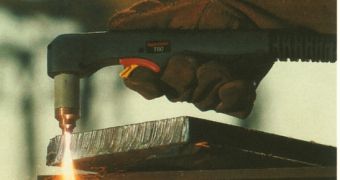Metals are basically used today in practically any application, due to their strength and durability. However, these two properties can quickly turn against the manufacturer, especially while shaping and cutting large pieces of metal, such as the 'I beams' used in skyscraper construction or other large support structures used in crane building or suspension bridges.
The plasma cutter, a marvelous device invented somewhere around the period of World War II, is able to execute precise and rapid cuts on relatively large metal pieces by harnessing one of the most common states of matter in the universe: plasma.
States of matter
Ordinary matter in the universe may be found in four states: solid, liquid, gas and plasma. Water, for example, experiences solid state when its molecules are arranged into a hexagonal crystal pattern, enabling them to remain stable relative position in relation to each other. To put it more simply, as solid, it is able to hold its own shape.
In liquid water, on the other hand, molecules are bound to each other, but have much more freedom to move in relation to each other. Liquids always have a fixed volume, and are able to take the shape of the container in which they are placed.
Water in a gaseous state is called Steam. Molecules in steam are able to move freely in relation to each other and at much higher speed than those experienced in liquid state. It has no fix volume or shape.
Plasma
Plasma is relatively similar to the gaseous state, however it is only obtained at very high temperatures. The extra amount of energy allows matter to break into its basic constituents, atoms, which may further split into electrons and nuclei which, in their turn, may break into protons and neutrons if the energy input in sufficiently high. Usually, plasma is experienced in a mix of electrons and ions, moving at very high speeds in relation to each other.
Plasma cutters
Plasma cutters work by creating a high velocity plasma flow between a negatively charged electrode and a positively charged one. The working gas is oxygen, nitrogen and argon. When power is applied between the negative and the positive electrodes, the pressurized working gas becomes ionized and a disruptive electrical charge is created between the two electrodes through the mass of gas - plasma by this point.
The electrical discharge heats up the plasma to even higher temperatures, practically melting the metal piece which must be cut - the metal is usually the positive electrode. The temperature can reach up to 16,649 degrees Celsius, while the plasma flow speed can accelerate to 6096 meters per second.
Alternatively, in order to create a channeled plasma flow and electrical discharge, the nozzle of the plasma cutter creates a gas shield around the plasma beam. As soon as the electrical flow between the two electrodes stops, the plasma experiences a sudden drop in temperature and matter returns to the gaseous state.

 14 DAY TRIAL //
14 DAY TRIAL //